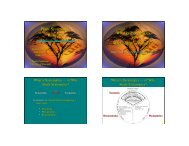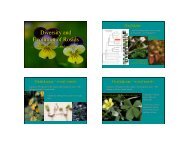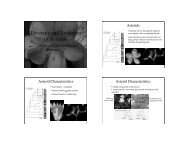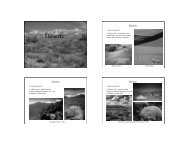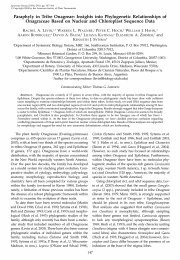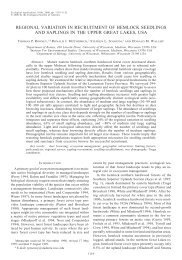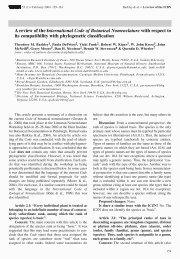Rhamnaceae - buckthorn family
Rhamnaceae - buckthorn family
Rhamnaceae - buckthorn family
You also want an ePaper? Increase the reach of your titles
YUMPU automatically turns print PDFs into web optimized ePapers that Google loves.
<strong>Rhamnaceae</strong> - <strong>buckthorn</strong> <strong>family</strong>!<br />
A large <strong>family</strong> of trees and shrubs in the tropics and temperate areas. In Wisconsin we have 2<br />
genera (Rhamnus and Ceanothus) and 6 species. Several are some of our most invasive<br />
shrubs in the forest sites you will study.<br />
Rhamnus cathartica - European or common <strong>buckthorn</strong> [invasive]<br />
Many of our species are armed<br />
with thorns<br />
Leaves are simple and alternate or<br />
opposite often with arcuate<br />
venation (arcing along the edge)<br />
Inner bark is bright green<br />
<strong>Rhamnaceae</strong> - <strong>buckthorn</strong> <strong>family</strong>!<br />
A large <strong>family</strong> of trees and shrubs in the tropics and temperate areas. In Wisconsin we have 2<br />
genera (Rhamnus and Ceanothus) and 6 species. Several are some of our most invasive<br />
shrubs in the forest sites you will study.<br />
Rhamnus cathartica - European or common <strong>buckthorn</strong> [invasive]<br />
Many of our species are armed<br />
with thorns<br />
Leaves are simple and alternate or<br />
opposite often with arcuate<br />
venation (arcing along the edge)<br />
<strong>Rhamnaceae</strong> - <strong>buckthorn</strong> <strong>family</strong>!<br />
A large <strong>family</strong> of trees and shrubs in the tropics and temperate areas. In Wisconsin we have 2<br />
genera (Rhamnus and Ceanothus) and 6 species. Several are some of our most invasive<br />
shrubs in the forest sites you will study.<br />
Rhamnus cathartica - European or common <strong>buckthorn</strong> [invasive]<br />
CA 4,5 CO 4,5 A 4,5 G (3)<br />
Flowers 4 or 5 merous (4 merous<br />
shown in common <strong>buckthorn</strong>)<br />
Stamens opposite the petals -<br />
unusual in flowering plants!<br />
2/15/10<br />
1
<strong>Rhamnaceae</strong> - <strong>buckthorn</strong> <strong>family</strong>!<br />
A large <strong>family</strong> of trees and shrubs in the tropics and temperate areas. In Wisconsin we have 2<br />
genera (Rhamnus and Ceanothus) and 6 species. Several are some of our most invasive<br />
shrubs in the forest sites you will study.<br />
Rhamnus cathartica - European or common <strong>buckthorn</strong> [invasive]<br />
CA 4,5 CO 4,5 A 4,5 G (3)<br />
Flowers 4 or 5 merous (4 merous<br />
shown in common <strong>buckthorn</strong>)<br />
Stamens opposite the petals -<br />
unusual in flowering plants!<br />
Fruits one-seeded drupes<br />
Shrubs often confused with cherries<br />
and hollies<br />
<strong>Rhamnaceae</strong> - <strong>buckthorn</strong> <strong>family</strong>!<br />
Ceanothus americanus<br />
New Jersey tea<br />
<strong>Rhamnaceae</strong> - <strong>buckthorn</strong> <strong>family</strong>!<br />
Rhamnus frangula<br />
Glossy <strong>buckthorn</strong> [invasive]<br />
Rhamnus alnifolia<br />
alder leaf <strong>buckthorn</strong> [native]<br />
Elaeagnaceae - Russian olive <strong>family</strong>!<br />
Elaeagnus angustifolia - Russian olive<br />
Russian olive <strong>family</strong> are small trees and<br />
shrubs easily recognized by silvery or<br />
reddish glandular hairs covering bottom<br />
leaves and/or stems<br />
Russian and autumn olive are invasive<br />
trees<br />
Elaeagnus umbellata -<br />
autumn olive<br />
2/15/10<br />
2
Elaeagnaceae - Russian olive <strong>family</strong>!<br />
Shepherdia argentea - silver buffaloberry<br />
(western N. Am. species)<br />
Shepherdia canadensis - buffaloberry<br />
Buffalo-berries are North<br />
American species with opposite<br />
leaves<br />
Ulmaceae - elm <strong>family</strong>!<br />
Flowers are bisexual but reduced and wind<br />
pollinated; they appear before the leaves<br />
Pistil is made of two fused carpels but only<br />
one seed matures; fruit is a samara - a<br />
winged achene is this case<br />
Note 2 styles on samara<br />
Ulmus americana - American elm<br />
Ulmaceae - elm <strong>family</strong>!<br />
A north temperate <strong>family</strong> of trees best known for the American elm with its distinctive vase<br />
shaped growth form. Dutch Elm disease, caused by the fungus Ceratostomella umli, is<br />
gradually destroying these magnificant trees. Dutch Elm disease was first discovered in this<br />
country in 1930.<br />
Leaves are distichously arranged - 2 ranks in<br />
one plane - and pinnately veined<br />
Ulmus rubra - red or slippery elm<br />
Leaf bases are strongly asymmetric<br />
Ulmus americana - American elm<br />
Ulmaceae - elm <strong>family</strong>!<br />
Red elm leaves are more sand<br />
papery in texture, less<br />
asymmetric at base; inner bark<br />
is reddish<br />
2/15/10<br />
3
Ulmus rubra - red or slippery elm<br />
Ulmaceae - elm <strong>family</strong>!<br />
Celtidaceae - hackberry <strong>family</strong>!<br />
Red elm leaves are more sand<br />
papery in texture, less<br />
asymmetric at base; inner bark<br />
is reddish<br />
Samaras are larger than the<br />
American elm and without<br />
fringe of hairs along edge<br />
A tropical and temperate group of small trees previously placed in Ulmaceae. Hackberries<br />
though are unisexual flowered. Leaves are strongly palmi-pinnate - with 3 main veins at base.<br />
Celtis occidentalis - hackberry<br />
Note distinctive warty bark<br />
Fruit is a one-seeded drupe,<br />
not a berry!<br />
Celtidaceae - hackberry <strong>family</strong>!<br />
A tropical and temperate group of small trees previously placed in Ulmaceae. Hackberries<br />
though are unisexual flowered. Leaves are strongly palmi-pinnate - with 3 main veins at base.<br />
Celtis occidentalis - hackberry<br />
Cannabinaceae - marijuana <strong>family</strong>!<br />
A small <strong>family</strong> of 2 genera and 3 species of herbs and vines. Plants palmately lobed<br />
(Humulus) or compound (Cannabis). Distinctively aromatic plants. Flowers unisexual.<br />
Cannabis sativa<br />
Hemp, marijuana<br />
Humulus lupulus<br />
American hops<br />
2/15/10<br />
4
Cannabinaceae - marijuana <strong>family</strong>!<br />
Male inflorescence<br />
Female inflorescence<br />
Seeds 1-seeded<br />
Cannabis sativa<br />
Hemp, marijuana<br />
Urticaceae - nettle <strong>family</strong>!<br />
Largely a tropical <strong>family</strong> of herbs and shrubs. In Wisconsin we have 5 genera and 6 species -<br />
all of them herbs and generally restricted to woodlands.<br />
Urtica dioica - stinging nettle<br />
Leaves have the palmipinnate<br />
venation; either<br />
alternate or opposite<br />
Cannabinaceae - marijuana <strong>family</strong>!<br />
Humulus lupulus<br />
American hops<br />
Under cultivation; notice the<br />
hop female inflorescences<br />
which is source of beer<br />
flavoring - lupulin<br />
Urticaceae - nettle <strong>family</strong>!<br />
Humulus japonicus<br />
Japanese hops [escaped]<br />
Largely a tropical <strong>family</strong> of herbs and shrubs. In Wisconsin we have 5 genera and 6 species -<br />
all of them herbs and generally restricted to woodlands.<br />
Urtica dioica - stinging nettle<br />
Some species, like stinging<br />
nettle, are a source of<br />
irritants found in specialized<br />
hair-like cells on stems and<br />
leaves<br />
2/15/10<br />
5
Urticaceae - nettle <strong>family</strong>!<br />
Largely a tropical <strong>family</strong> of herbs and shrubs. In Wisconsin we have 5 genera and 6 species -<br />
all of them herbs and generally restricted to woodlands.<br />
Urtica dioica - stinging nettle<br />
Urticaceae - nettle <strong>family</strong>!<br />
Some species, like stinging<br />
nettle, are a source of<br />
irritants found in specialized<br />
hair-like cells on stems and<br />
leaves<br />
Flowers are reduced and<br />
unisexual, in congested<br />
inflorescences, and mostly<br />
wind-pollinated<br />
Leaves are palmi-pinnate as in other related families of the Rosales. Genera in Wisconsin can<br />
be separated by leaf arrangement, presence of stinging hairs, and inflorescence features.<br />
Urtica dioica - stinging nettle<br />
[opposite leaves, stinging]<br />
Laportea canadensis - wood nettle<br />
[alternate leaves, stinging]<br />
Urticaceae - nettle <strong>family</strong>!<br />
Largely a tropical <strong>family</strong> of herbs and shrubs. In Wisconsin we have 5 genera and 6 species -<br />
all of them herbs and generally restricted to woodlands.<br />
Urtica dioica - stinging nettle<br />
Boehmeria cylindrica<br />
False nettle<br />
Urticaceae - nettle <strong>family</strong>!<br />
Pilea pumila<br />
clearweed<br />
Some species, like stinging<br />
nettle, are a source of<br />
irritants found in specialized<br />
hair-like cells on stems and<br />
leaves<br />
Flowers are reduced and<br />
unisexual, in congested<br />
inflorescences, and mostly<br />
wind-pollinated<br />
Stamens have a peculiar<br />
elastic spring-like mechanism<br />
that flings pollen further out<br />
from the plant<br />
Parietaria pensylvanica<br />
pellitory<br />
2/15/10<br />
6
Moraceae - mulberry <strong>family</strong>!<br />
A large and important <strong>family</strong> of tropical trees<br />
(figs, breadfruit). Two genera (Morus and<br />
Maclura) with 3 species occur in Wisconsin,<br />
although only 1 is native.<br />
Well developed latex system occurs in the<br />
<strong>family</strong> and thus is easy to recognize by usually<br />
milky sap when leaves or stems are cut.<br />
Leaves are alternate, strongly palmi-pinnately<br />
veined.<br />
Morus alba - white mulberry (introduced,<br />
source of food for silk worms in the Orient) -<br />
has characteristic variable lobing of leaves.<br />
Morus alba - white mulberry<br />
Moraceae - mulberry <strong>family</strong>!<br />
Red mulberry is our one native species, and<br />
is quite rare and is a riparian edge specialist<br />
Morus rubra - red mulberry<br />
Moraceae - mulberry <strong>family</strong>!<br />
Flowers reduced, unisexual, no petals<br />
Single seeded fruits (fleshy achenes or drupelets)<br />
from many flowers coalesce to form one fleshy,<br />
multiple fruit [e.g., mulberry, fig, breadfruit]<br />
Morus alba - white mulberry [left - female ; right -<br />
male]<br />
Moraceae - mulberry <strong>family</strong>!<br />
Note the multiple fruit - derived from an<br />
entire inflorescence, not from just one<br />
flower<br />
Morus rubra - red mulberry<br />
2/15/10<br />
7
Maclura pomifera - osage orange<br />
Moraceae - mulberry <strong>family</strong>!<br />
Cross section of multiple fruit<br />
showing individual oneseeded<br />
fruitlets<br />
Fabaceae!<br />
Osage orange is not native but often<br />
seen escaped; note the large<br />
grapefruit sized multiple fruit<br />
Most of the legumes are compound leaved -<br />
pinnately, palmately, trifoliolate - a few are<br />
simple leaved<br />
Fabaceae!<br />
Fabaceae!<br />
Produce specialized follicles - legumes -<br />
that open along two lines of dehiscence<br />
• These are all now treated as one<br />
<strong>family</strong> called the Fabaceae or<br />
Leguminosae<br />
• Older manuals and WisFlora separate<br />
into distinct families<br />
“caesalpinoids” = Caesalpiniaceae<br />
“faboids” = Fabaceae<br />
Most of the legumes are compound leaved -<br />
pinnately, palmately, trifoliolate - a few are<br />
simple leaved<br />
Stipules are generally<br />
well- developed<br />
2/15/10<br />
8
CA 5 CO 5 A 10 G 1<br />
Flowers 5 merous with 10<br />
stamens; topmost petal =<br />
banner sits in front of the 2<br />
lateral or wing petals<br />
Gynoecium monocarpic and<br />
forms the legume<br />
Cercis canadensis - eastern redbud<br />
NOT native<br />
“caesalpinoid” legumes!<br />
1 carpel<br />
legume<br />
Chamaecrista fasciculata<br />
golden cassia, locust-weed)<br />
“caesalpinoid” legumes!<br />
Senna marilandica - southern wild senna<br />
“caesalpinoid” legumes! “caesalpinoid” legumes!<br />
2/15/10<br />
9
“faboid” legumes!<br />
CA (5) CO 3+(2) A (9)+1 G 1<br />
2 keel petals<br />
2 lateral petals<br />
“faboid” legumes!<br />
80 species in Wisconsin;<br />
many with root nodules for<br />
N2 fixation<br />
Calyx often fused<br />
Banner petal behind lateral<br />
petals<br />
Bottom keel petals often<br />
fused<br />
Stamens diadelphous =<br />
9 fused + 1 separate<br />
banner petal<br />
Coronilla varia - crown vetch Desmodium canadense - ticktrefoil<br />
Apios americana - groundnut<br />
Lathyrus japonicus - beach pea<br />
“faboid” legumes!<br />
“faboid” legumes!<br />
Lupinus perennis - lupine<br />
Baptisia bracteata - creamy wild indigo<br />
2/15/10<br />
10
Polygala paucifolia<br />
gaywings, flowering wintergreen<br />
Early flowering plant of northern<br />
hardwood pine forests<br />
“faboid” legumes!<br />
Polygalaceae - milkwort <strong>family</strong>!<br />
Polygala sanguinea<br />
purple milkwort<br />
Robinia pseudo-acacia - black<br />
locust<br />
A small <strong>family</strong> of herbs with flowers<br />
reminiscent of legumes; their closest<br />
relatives; milky latex in plant<br />
Melilotus alba<br />
White sweet clover<br />
Medicago sativa<br />
alfalfa<br />
“faboid” legumes!<br />
Vicia villosa<br />
Hairy vetch<br />
Polygalaceae - milkwort <strong>family</strong>!<br />
Polygala polygama - bitter milkwort<br />
Species characteristic of sandy soils; note the<br />
cleistogamous flowers = closed and selfing vs.<br />
chasmogamous = open and outcrossed<br />
Trifolium pratense<br />
Red clover<br />
2/15/10<br />
11



